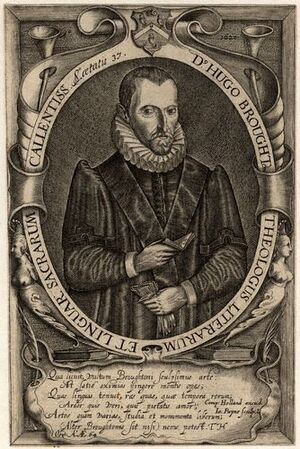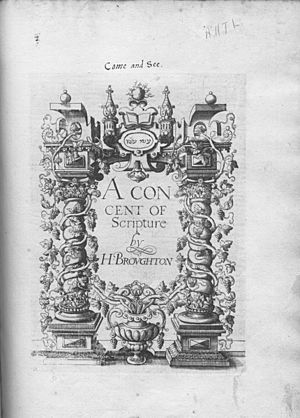Hugh Broughton facts for kids
Hugh Broughton (born 1549 – died 4 August 1612) was an English expert in ancient languages and religious studies. He was known for his deep knowledge of Hebrew and his strong opinions on how the Bible should be understood and translated.
Contents
Early Life and Learning
Hugh Broughton was born in 1549 in Owlbury, a small place near Bishop's Castle in Shropshire, England. He often said he had Welsh family roots.
He went to school with Bernard Gilpin at Houghton-le-Spring. Later, he studied at Magdalene College, Cambridge, starting in 1570. During his first year at Cambridge, he began learning Hebrew by attending lectures given by a French scholar named Antoine Rodolphe Chevallier. This was the start of his amazing skill in Hebrew.
Cambridge University Years
Broughton earned his first degree (B.A.) in 1570. He became a fellow at St John's College and later at Christ's College. A "fellow" is like a senior researcher or teacher at a university.
He had important people who supported him. Sir Walter Mildmay gave him money to teach Greek privately. Henry Hastings, 3rd Earl of Huntingdon, also helped him financially so he could continue his studies. He was chosen as one of the university's "taxers," who helped manage university finances. He also got a special position and a teaching role in religious studies at Durham.
In 1579, he lost his fellowship because he held the Durham position. But in 1581, Lord Burghley, a very powerful person, helped him get it back. Lord Burghley was convinced by other important people like the Bishop of Durham and the Earl of Huntingdon. After this, Broughton left his taxer job and didn't return to the university.
Life in London
After leaving Cambridge, Broughton moved to London. He spent a lot of time studying and became known as a preacher with strong puritan beliefs. Puritans were a group of Protestants who wanted to make the Church of England simpler.
It's said that in one of his sermons in 1588, he predicted that the Spanish Armada (a huge Spanish fleet trying to invade England) would be defeated. He made friends in London, especially with the Cotton family, who he lived with and taught Hebrew.
In 1588, his first book, A Concent of Scripture, was published. He dedicated it to Queen Elizabeth I. This book talked about how different parts of the Bible fit together over time. Other scholars, like John Rainolds and Edward Lively, disagreed with his ideas and criticized his book.
Broughton asked the Queen and important bishops to help settle the arguments about his book. He started giving weekly lectures to defend his ideas, with many scholars attending. He even got permission to give these lectures at St Paul's Cathedral. But some bishops complained, calling his gatherings "conventicles" (secret religious meetings). So, he moved his lectures to other places in London. Because he felt unsafe, he decided to leave England.
Traveling and Debates
Around 1589 or 1590, Broughton traveled to Germany with a student. While abroad, he debated with Catholic scholars and discussed religion with several Jewish rabbis. In 1590, he had a famous debate with Rabbi Elias in a synagogue in Frankfurt.
He returned to England in 1591. He tried to settle his disagreements with John Rainolds about Bible timelines, but nothing came of it. Queen Elizabeth's chief minister, John Whitgift, also seemed to work against Broughton.
In 1592, Broughton was back in Germany. He continued to debate and try to gain recognition. He wrote strongly against Theodore Beza, another scholar, and believed that bishops were important leaders in the church, just as they were in early Christian times.
Between 1605 and 1608, Broughton helped set up the English Reformed Church in Amsterdam. This church was for English people living in Amsterdam who followed the Reformed religion.
Challenges Under King James I
In 1603, Broughton preached a sermon to Henry Frederick, Prince of Wales, about the Lord's Prayer. Soon after, he moved to Middelburg and became a preacher for the English community there.
Around this time, King James I decided to create a new translation of the Bible (which became the famous King James Bible). Broughton's old rival, Rainolds, had pushed for this new translation. However, to Broughton's great disappointment, he was not chosen to be one of the fifty-four scholars who worked on it.
Broughton was very critical of the new Bible translation. He also wrote a harsh pamphlet against Richard Bancroft, an important bishop, which didn't help his reputation. The famous writer Ben Jonson even made fun of Broughton in his plays, Volpone (1605) and The Alchemist (1610). Despite this, Broughton kept writing and publishing many works. He dedicated his translation of the Book of Job (1610) to the King.
Return to England and Death
By 1611, Hugh Broughton was very sick with a lung illness called consumption. He made his last trip back to England, arriving in November. He told his friends he had come home to die and wished to die in Shropshire, where his former student, Sir Rowland Cotton, lived.
However, he was too weak to travel that far. He spent the winter in London and moved to Tottenham in the spring. He stayed there until autumn, living in the house of a friend. He passed away on 4 August 1612. He was buried in London on 7 August. He had married a woman named Lingen, who was the niece of his student, Alexander Top.
Hugh Broughton's Writings
Hugh Broughton wrote many books and letters during his life.
In 1588, he published his first major work, A Concent of Scripture. This book explored how different parts of the Bible's history and text fit together. It caused a lot of debate at the universities, and Broughton had to give lectures to defend his ideas.
While in Middelburg, he printed An Epistle to the learned Nobilitie of England, touching translating the Bible from the Original in 1597. He had already written to the Queen about his idea for a better Bible translation. His plan was to work with five other scholars to make only necessary changes and add short notes. Even though important lords and bishops supported his idea, he couldn't get the money or support to carry it out. He believed that Archbishop Whitgift was preventing his new translation from happening.
In 1599, he published his explanation of the article about Christ's descent into hell. He strongly argued that "Hades" (the place mentioned in the Bible) meant the state of souls after death, not a place of punishment.
In 1610, his book A Revelation of the Holy Apocalyps was printed. In this book, he argued that Hades only has two places: heaven and hell. He also stated that purgatory (a place of cleansing for souls, believed by some Christians) does not exist.
Some of his works were collected and published in a large book in 1662. This collection included a short story about his life written by John Lightfoot. Some of his handwritten religious papers are kept in the British Library.




